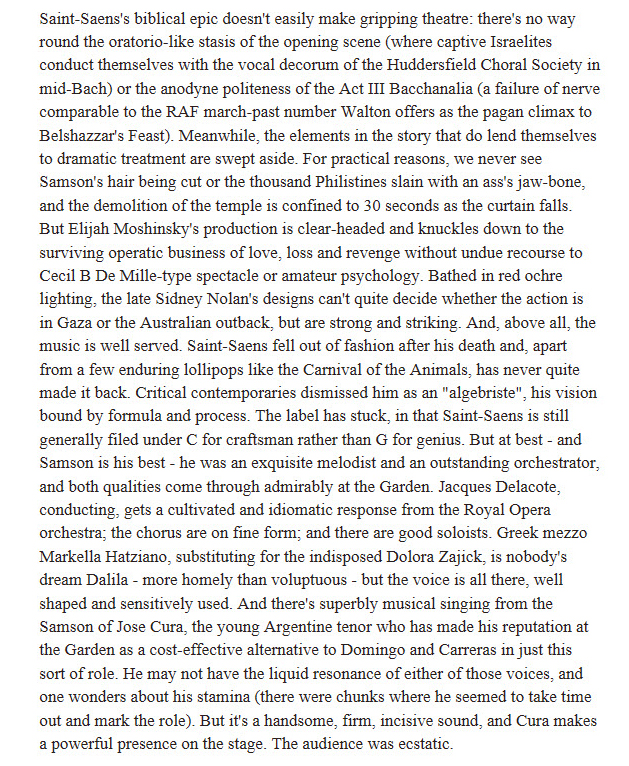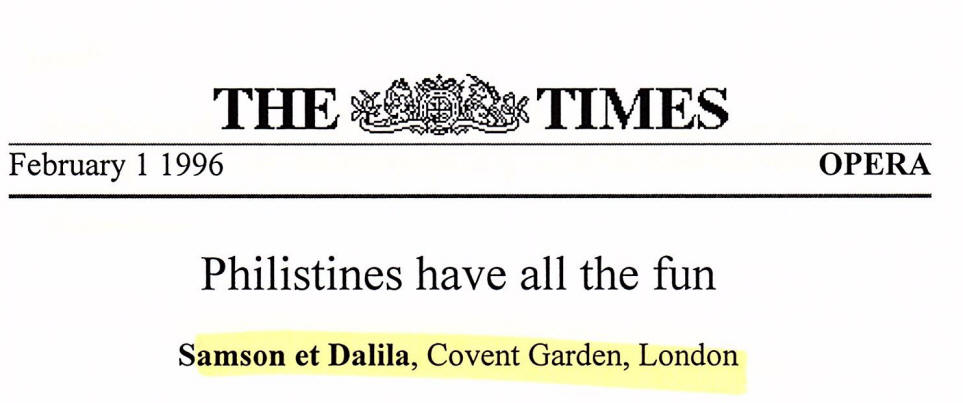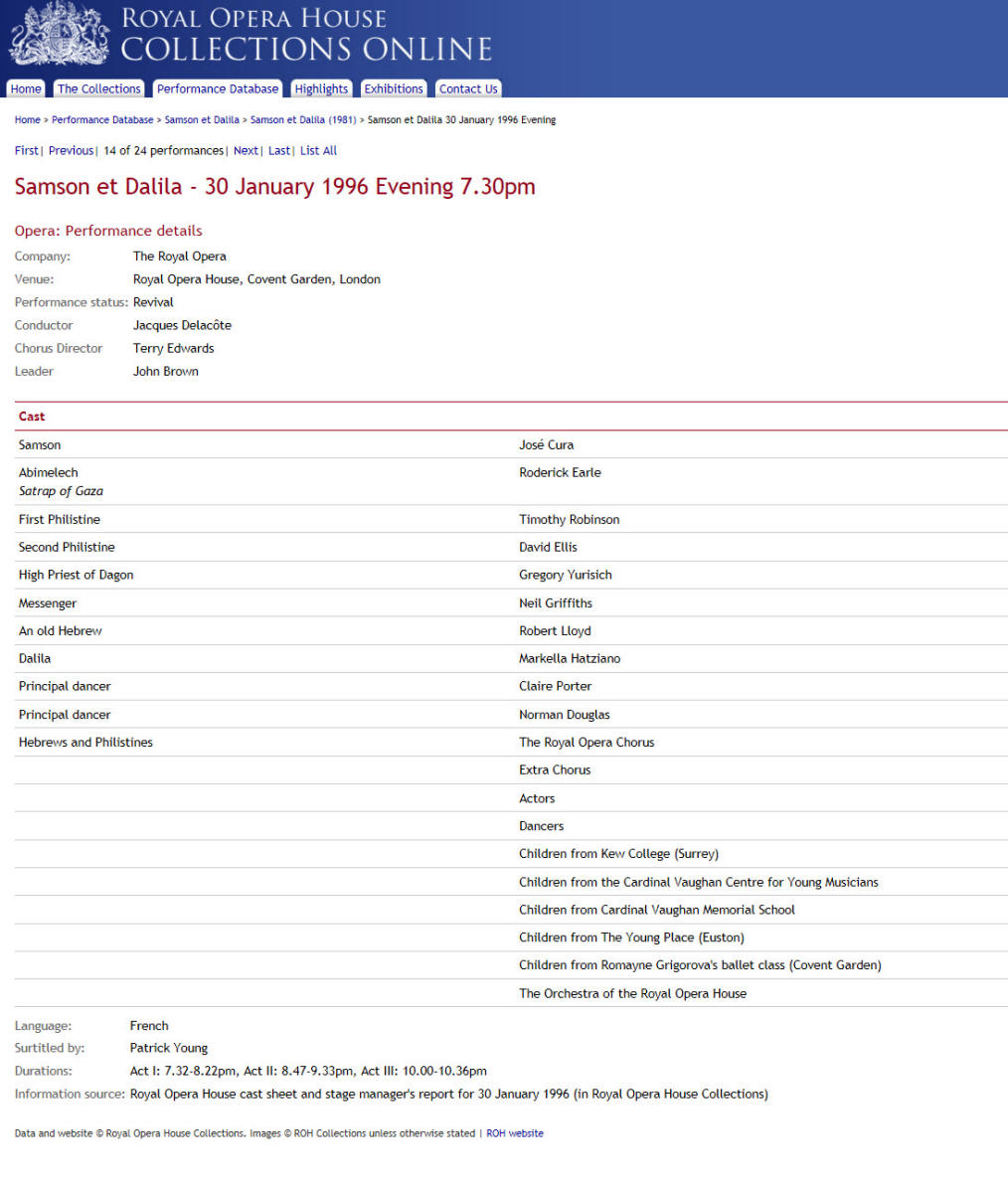
Bravo Cura
Celebrating José Cura--Singer, Conductor, Director
Operas: Samson

Same production, two different theaters in two different countries: Cura's first professional Samson in 1996 at the Royal Opera in London and his 'cover' in 2001 at Gran Liceu in Barcelona.
|
|
So, here's the deal: José Cura performed as Samson at ROH in a shared production that subsequently traveled to the Gran Liceu in 2001. THAT production was set to star a different José, but when he got sick, our José jumped in and saved the day. All is good.
Except that the two productions in two different theaters also used the same Dalila.
SO....in chasing these Samson productions across the internet we have a few photos that could be from either place and nothing really distinguishes London from Barcelona.
We have done our best to make sure we have the right photos assigned to the right theater--we ended up relying on the headband to differentiate (braided in London, flat in Barcelona) but that is just a best guess. Sorry if we misidentified a few!
Royal Opera House 1996
Samson et Dalila, London, January 1996: Argentinian tenor José Cura, singing Samson for the first time, gives a superb performance in the opera by Camille Saint-Saens and proves that he is surely one of the up-and-coming top tenors of the Nineties. The Lady, 6 January 1996
Samson et Dalila, London, January 1996: José Cura adds to his growing reputation and repertoire or roles with a charismatic and sexy Samson. He generates a powerful intensity and flashes enough calf and thigh to convince he is capable not only of leading the Israelites but of inflaming Dalila’s heart—no wonder she is cross he ditched her after a single day of passion. His ardent and sensitive singing movingly projects Samson’s anguished soul. “Vois ma misère (Act III) was heartrending. The Stage, 8 February 1996
Samson et Dalila, London, January 1996: José Cura looks and sounds the part of Samson, strongly athletic and in very robust voice, he makes the part come alive completely. What’s On London, 7 February 1996
Samson et Dalila, London, January 1996:
And there’s superbly musical singing from the Samson of José Cura, the young Argentine tenor who has made his reputation at the Garde. […] It’s a handsome, firm, incisive sound, and Cura makes a power presence on the stage. The audience was ecstatic. Independent on Sunday, 4 February 1996Samson et Dalila, London, January / February 1996: “Due to the sterling efforts of José Cura, the young Argentinean who never seems to put a foot wrong. His Samson is full of soul; a commanding and vibrant tenor performance that captures the Hebrew leader's weaknesses with as much theatrical devotion as his god-like strengths.” The Evening Standard, January 1996
Samson et Dalila, London, January 1996: “The great thing is that he does sing softly, much of the erotic charge of the second act was the result of his sensitive caressing of the vocal lines.” The Times, January 1996



[Excerpt]
| As heady a brew of sex 'n'
religion as ever came out of the
19th century, Saint-Saëns'
biblical opera is always welcome
back on the Covent Garden stage. The title roles were most engagingly sung....José Cura is picking up a lot of dates that the Three Tenors cannot or will not manage and is proving himself a worthy Fourth. An earlier problem of unfocused pitch when singing softly is receding and the great thing is that he does sing softly: much of the erotic charge of the second act was the result of his sensitive caressing of the vocal lines. At full throttle the sound is thrilling and this big, handsome man certainly brings a Victor Mature dimension to his portrayal of Samson, cheerfully flaunting as much lower limb as the lancers in the Bacchanale. (And not of of it that low--I have not seen so much tenor rump on the Covent Garden stage since Peter Hoffmann accidentally exposed himself in Parsifal.)
|
| Bringing the House Down Our World Andrea Kirkby February 1996
José Cura proved a sensitive and touching Samson. His top notes in the love duet were luminous, almost falsetto, tender, and he sang a long, expansive lyrical line; yet in his final scene he managed to summon up almost raucous determination. The single greatest scene of the opera was his extended solo, pushing the grinding wheel to which he's manacled around the harshly lit circle of the threshing floor; pity and savagery blended in this complete portrayal of a man--just a man, not a hero; a man torn between emotions, brooding, [as] obsessive as the music. (Taking his curtain call, he seemed still stunned by the emotions of the role.)
Moshinsky's production did not make the best of the potential of the design, failing to mass his chorus with enough power. The most dramatic moment of the betrayal is muffed. Moshinsky stand rebuked, in my mind, by the power of Cura's solo scene--so much more convincing than any of the traffic directing the rest of the production.
|
José Cura performance dates:
30 January 1996
2, 5, 10, 15 February 1996

|
|
Gran Liceu 2001
One performance: 18 March 2001
|
Unforeseen Debut of José Cura (at Gran Liceu) Emrique Esquenazi [Excerpt] Now to the star of the show: the Argentinean tenor José Cura. He is a stage animal. His presence has such electricity it is almost impossible to take your eyes off him. He simply fills the stage. The magnetism is captivating to the point that there are more opportunities to be trapped by the eyes and become more indifferent to the ears. After 'Arretez, o mes freres!' the vocal problems were exposed... yes, everything was there to be heard, but his presence and acting convinced that he was Samson. Vocally there was little difference between the heroic character of the first act and the tormented lover, struggling internally and finally seduced in the second, until the vanquished, anguished and vengeful hero of the last act. The singing was always raw but none of this seemed to bother the audience, who clapped wildly and offered a final standing ovation. Yes, the show was undoubtedly a great triumph for Cura. Certainly he scored a public success in his debut at the Liceu. And at last I could understand the reason for the public uproar.
|
| Samson and Dalila at Gran Teatre del Liceu
Trubadur Aleksandra Toczko 20 March 2001
[Excerpt] [...] So I watched two shows – one with José Carreras and one with José Cura - very different from each other. This is a great opportunity, especially since I think that José Cura, because of his interesting voice, interesting interpretation and great appearance, is one of the most interesting tenors of the younger generation. During the first act, José Cura was a bit hidden and probably did not evoke any great emotions; by the second act, José Cura rose to the tops, singing in a strong voice and playing dramatically his role. Cura was a good tenor singing with all his notes in a beautiful voice. In the final of the third act, both tenors were great but objectively speaking, it seemed that the heroic voice of the Argentinean was better than the voice of lirico spinto Spaniard.
|
|
Cura's Spectacular Samson Vanguardia Roger Alier 19 March 2001 Because of José Carreras' illness yesterday, the Argentinean tenor, José Cura, performed in Samson with the remainder of the current cast. At first, welcomed with a certain reserve, at the end of the performance he certainly received one of the epic ovations for a tenor. He triumphed completely. Cura sang Samson--an opera that he knows perfectly--with spirit, guts and a taut and vibrant voice which gave to his character a dramatic force that corresponded to the action on the stage. From the very first first act he showed himself to be up to the role, in the second act his hot, amorous declarations to the seductress Dalila were truly striking and they created a real expectation. However, the most spectacular moments came in the third act. Few times have we heard the sad monologue of the mill-turning sung more emotionally, dramatically, and movingly that from the mouth of José Cura. Then, in the Bacchanale, his performance was immense, without neglecting the vocal demands: he thrust himself into the crowd [of people on stage], rolled towards the ground in his knot of chains, and rose up to bring down the pillars of the blazing temple with a high note that sent the audience into delirium.
|
|
|
Last Updated: Saturday, April 27, 2019 © Copyright: Kira